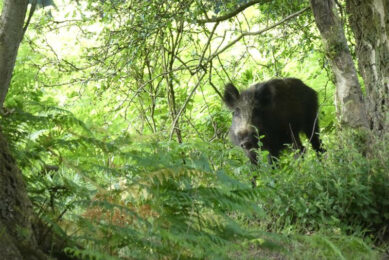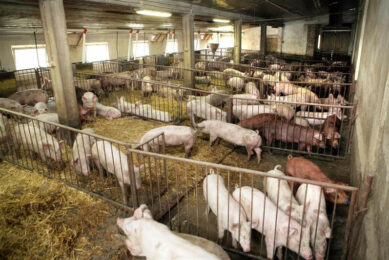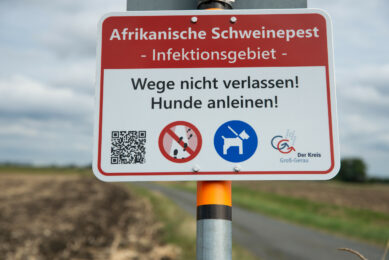Mitigation strategies for ASFv in feed

In order to get the spread of African Swine Fever virus (ASFv) under control, it is good to understand the potential route of transboundary transmission in the feed supply chain. Research has confirmed that ASFv is viable in feed ingredients during processing, storage and transportation. Which mitigation strategies exist for ASFv occurrence in swine feed?
A variety of virus survival conditions must be met from initial contamination of a feed ingredient until consumption by pigs on a farm to lead to an infection. First, the virus in a feed ingredient must survive drying, processing, storage, transportation and temperature. Then the contaminated feed ingredient must contain a virus concentration greater than the minimum infectious dose to infect pigs. The ASFv half-life under trans-oceanic shipping conditions ranges from 14.2 days in complete feed to 9.6 days for conventional soybean meal. In addition, contamination risks are higher when pre-harvest or post-harvest grains and crops are exposed to infected wild boars, infectious pests, vehicles, and/or infectious fomites such as personnel shoes, and multi-use containers.
Implementing feed biosecurity
Feed biosecurity is an essential component for preventing the introduction of ASFv into the pig farms. The biosecurity of the feed manufacturing plants is an essential part of the overall feed biosecurity programme against ASFv, because various types of feed ingredients from different regions are stored, mixed and processed in these facilities. In addition, sanitary transport, a commonly overlooked biosecurity measure in feed supply chain, must be applied for trucks, driver’s shoes, bags and totes.
Feed biosecurity risk assessment considers the following facts regarding each feed ingredient: First and foremost, each feed ingredient must be necessary for health and growth and lack a lower-risk alternative. In addition, the ASFv status including outbreaks and endemic case of ASF, and epidemiological situations in the country of origin for each ingredient must be considered. Furthermore, the environmental stability of ASFv in each feed ingredient must be identified. Feed biosecurity protocols including restricting the access of people and vehicles, decontaminating transport and delivery vehicles, prohibiting high-risk product entry, performing pest control, and providing training on safe feed handling must be implemented on-farms, as well.
Physical treatment of feed ingredients
Feed quarantine
Feed quarantine is a physical ASFv mitigation strategy applied for ingredients imported from high-risk areas/countries allowing for 99.99% degradation of ASFv before adding those ingredients into the diet. The quarantine time for conventional soybean meal, organic soybean meal, and choline ranges from 125 to 168 days at 12.3°C, from 39 to 494 days at 4°C, from 13 to 182 days at 15°C, and 13 to 26 days at 30°C. The quarantine time for unprocessed grains, oilseeds and associated meals includes at least 100 days at 10°C or 20 days at 20°C.
Although quarantine time is a simple and effective way of ASFv mitigation, the storage process is costly, and a frequent inventory turnover is required to lower ingredient procurement and feed manufacturing cost. In addition, temperature, relative humidity and duration of quarantine may lead to feed safety concerns and loss in the nutritional value of ingredients.
Heat treatment
Heat treatment of feed ingredients enhances the rate of ASFv degradation, thus decreasing the risk of ASFv depending on the temperature and duration. It is recommended to perform heat treatment for 30 minutes at 70°C or 5 minutes at 85°C. The virucidal effect of heat treatment against ASFv in feed ingredients is as low as 60°C.
Irradiation process
Application of ultraviolet irradiation is another effective physical process to inactivate ASFV in feed. For example, this method reduces the infectivity of the virus by 99.99% when used during the spray drying process of liquid porcine plasma.
Chemical treatment of feed ingredients
Feed additives
Feed additives with antimicrobial activity against ASFv can be used to mitigate the risk of ASFv in swine feed. Additives including aqueous formaldehyde, medium-chain fatty acids, short-chain fatty acids, organic acids, and essential oils have confirmed antiviral properties. Both medium-chain fatty acids and aqueous formaldehyde have been experimentally confirmed for ASFv mitigation in conventional soybean meal, organic soybean meal, soy oilcake and choline. Medium-chain fatty acids interrupt the viral envelope, deconstruct the virion and disrupt ASFv binding to the host cell for entry, thus decreasing its infectivity. Aqueous formaldehyde decreases ASFv infectivity via alkylation and cross-linking of viral nucleic acids and proteins.
Acidifiers
Acidifiers including caprylic, capric, and lauric acids have antiviral properties and inhibit ASFv infectivity in feed ingredients. Spray mixing of cereal ingredients including maze and rice bran with buffered formic acid produces a consistent and durable level of formate and a consistent acidification to less than pH 4. The buffered formic acid is not effective on meat/bone meal contaminated with ASFv.
What are the challenges?
Due to the lack of monitoring and surveillance system, there is a high uncertainty of the extent of ASFv contamination in global feed supply chains. In addition, sufficient details and data are lacking to accurately predict whether feed contaminated with ASFv can cause an infection in pigs. Furthermore, limitations of current analytical methods for measuring virus inactivation, viability, and infectivity in feed prevent the development of quantitative risk assessment models. Moreover, most methods of mitigation do not eliminate ASFv DNA from feed, thus featuring the importance of determining virus biological infectivity after applying mitigation strategies.
Concluding remarks
The global feed supply chain is a potential route for transboundary transmission of ASFv through international trade and travel to various pig farms. Implementing feed biosecurity, and physical and chemical treatments provide opportunities to reduce ASFv risks in pig feed. There are various challenges to improving mitigation strategies. Therefore, further large-scale studies are necessary to provide sufficient detail to develop risk assessment models for ASFv contamination in swine feed.
References are available upon request.











